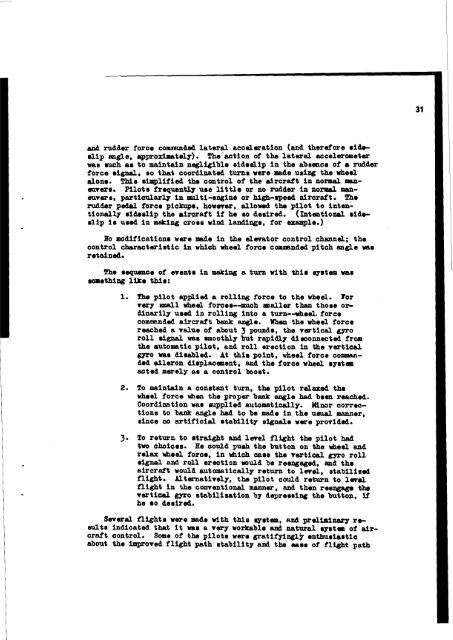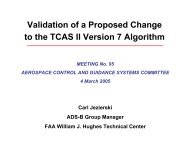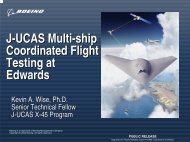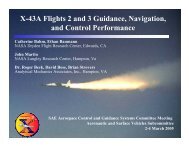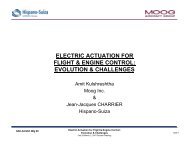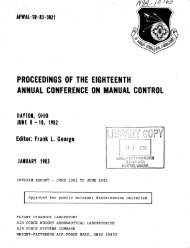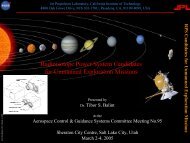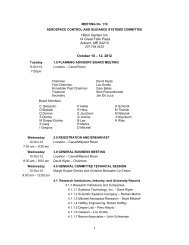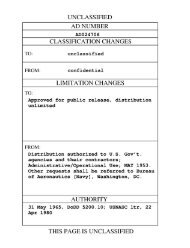Report of the Second Piloted Aircraft Flight Control System - Acgsc.org
Report of the Second Piloted Aircraft Flight Control System - Acgsc.org
Report of the Second Piloted Aircraft Flight Control System - Acgsc.org
Create successful ePaper yourself
Turn your PDF publications into a flip-book with our unique Google optimized e-Paper software.
and rudder foroe commended lateral acceleration (and <strong>the</strong>refore ridodip<br />
angle, epprox5mately). Thn 'action <strong>of</strong> <strong>the</strong> lateral acceleometar<br />
vae such ar to maintain negligible aidedip in <strong>the</strong> absence <strong>of</strong> a rudder<br />
force migaal, 80 that coordinatod turnr were made uripg <strong>the</strong> vheel<br />
alone. This rimplified <strong>the</strong> control <strong>of</strong> <strong>the</strong> efrcraft in nornal mancnvarr.<br />
Pilotr frequently ure little or no rudder in normel mancutere,<br />
particularly in nailti-e~gin6 or high-.peed drcrait. The<br />
rudder pedal force pickupr, hovewar, dlo- <strong>the</strong> pilot to intentionally<br />
ridedip <strong>the</strong> aircraft if he eo deeired. (~ntslrtiond. ridedip<br />
ir urd in making crone vird landingr, for example.)<br />
No modification8 were made in <strong>the</strong> elevator control channel; <strong>the</strong><br />
control characterirtic in vhich wheel force conumnded pitch angle wr<br />
retained.<br />
Phe roqme <strong>of</strong> event8 in making a turn vith thir ayrtam war<br />
romethipg like thin:<br />
1. The pilot applied a rolling force to <strong>the</strong> vheel. For<br />
very -1 uhed forces--muah mailer than thore or<br />
dinarily usad in rolling into a t&n--wheel. force<br />
con=nded aircraft bank angle. When <strong>the</strong> vheel foroe<br />
reached a value <strong>of</strong> about 3 poundr, <strong>the</strong> tartical gro<br />
roll rignal war smoothly but rapidly (Umonnected from<br />
<strong>the</strong> automatic pilot, and roll erection in <strong>the</strong> rartical<br />
gyro war 'disabled. At thir point, wheel force commaadad<br />
eilaron dirplacs~lent, and <strong>the</strong> force vhsel ryrtcm<br />
acted merely ar a control booat.<br />
2. To maintain a conrtsnt turn, <strong>the</strong> pilot relaxdl <strong>the</strong><br />
vhedt force &en <strong>the</strong> proper bank angle had bran reached.<br />
Coordination war aupplied automat i dly. Winor correctione<br />
to bank angle had to be made in <strong>the</strong> uoual manner,<br />
since no artificial rtability elgnalr vare provided.<br />
3. To return. to straight and lwel flight <strong>the</strong> pilot hat<br />
two choicee. Ee oould push <strong>the</strong> but ton on <strong>the</strong> rrheel and<br />
relax uheel force, in vhich care <strong>the</strong> vertical gyro roll<br />
rignrrl and roll erecrtion would be reengaged, end <strong>the</strong><br />
aircrait vdd automatically return to lsrel, etabiliswl<br />
flight. Alternatively, <strong>the</strong> pilot could return to lmel<br />
flight in <strong>the</strong> conventional manner, and <strong>the</strong>n reerrgage <strong>the</strong><br />
vertical gyro etabilisation by bepramring <strong>the</strong> button, ii<br />
he 80 derirul.<br />
Smsral flightr vee ma40 vith thie eyrtsm, and pralirpinery redtr<br />
indicated that it war a very workable and natural ryrtmn <strong>of</strong> edrcraft<br />
control. Some <strong>of</strong> <strong>the</strong> pilotr vsre gratifylrrglf enthuriartic<br />
about <strong>the</strong> Improved flight path atability ad <strong>the</strong> sere <strong>of</strong> fl- path


